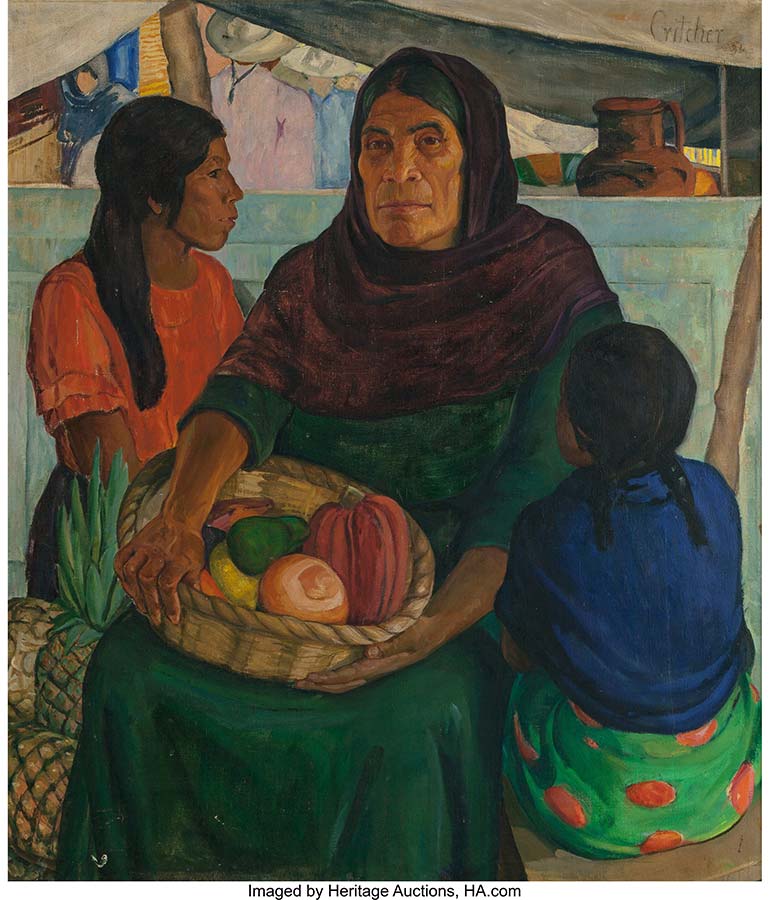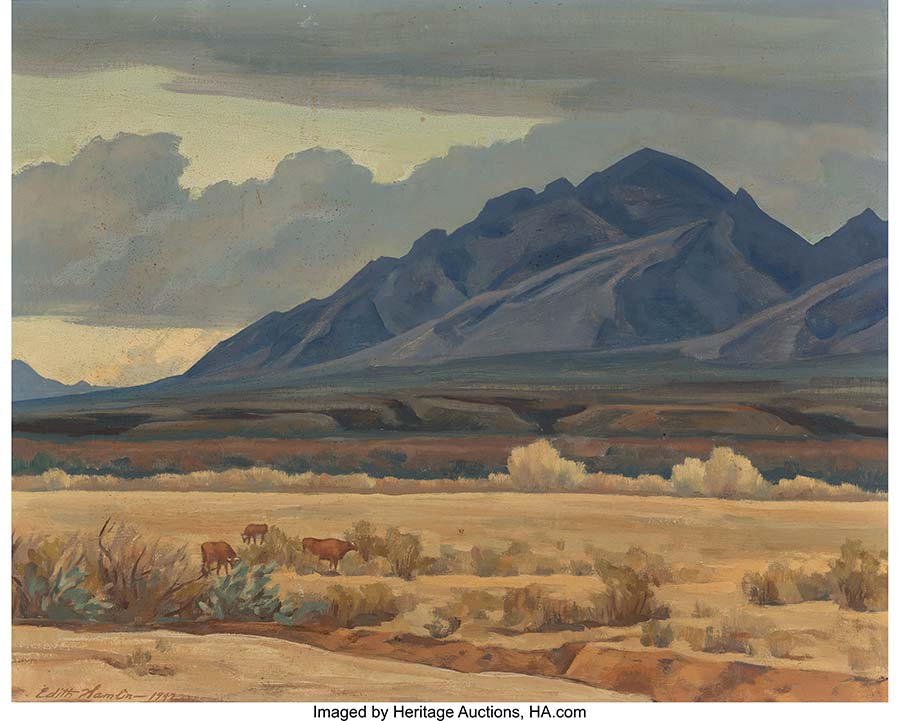HERITAGE AUCTIONS ART EXPERTS ON THE FEMALE ARTISTS WHO FASCINATE, INSPIRE AND DELIGHT THEM
To celebrate Women’s History Month, we asked Heritage’s in-house experts about their favorite women artists. Their responses ranged from a provocative American artist currently leaving her mark on the art world to a Dutch flower painter who first captured imaginations in the late 17th century. To see more work by noteworthy female artists this month, check out Heritage’s In Focus: Women Photographers event on March 9 and the Women of the West Showcase Auction on March 25.
Enlarge

MICKALENE THOMAS
“Nobody captures a woman’s sex appeal, confidence and style quite like Mickalene Thomas. Influenced by the glam aesthetics of the 1970s, Thomas produces portraits of African American women using contemporary celebrity photography to render her subjects as powerful agents of their identities. Often depicting her sitters, whom the artist frequently refers to as ‘muses,’ in the poses of the odalisques of Jean-Auguste-Dominique Ingres and Édouard Manet, Thomas subverts traditional forms of representation and presents a complex and empathetic vision of the myriad experiences of Black women in contemporary America. Her sitters often return the viewer’s gaze, supercharging a powerful presence.” –Aviva Lehmann, Senior Vice President, American Art
Enlarge

CATHARINE C. CRITCHER
“I have long been an admirer of the Taos Society of Artists. And while many collectors think of names such as Joseph Henry Sharp, Bert Phillips, E.I. Couse, Ernest Blumenschein, Walter Ufer and E. Martin Hennings, rarely do we see works come to market by the only woman unanimously elected into the all-male Taos Society of Artists, Catharine Critcher. Long before her move to Taos in 1924, at the age of 58, she had established an impressive career as a portraitist and art educator. For Critcher, the lure of Taos was less the financial gain associated with lucrative illustration assignments than it was the prospect of experiencing a new culture and finding new portrait subjects. Critcher’s perspective of life in Taos is vibrant, fresh, modern, beautiful and unique, and she rendered her ‘models galore’ – whether women at work, mothers with children or Indian chiefs – with special sensitivity to facial expressions and colorful native clothing.” –Alissa Ford, Director, California & Western Art
Enlarge

JOAN MITCHELL
“Joan Mitchell’s paintings are some of the highest-grossing at auction for a female artist. A lot of people forget she actually started as a printmaker at the Art Institute of Chicago in 1944. Her lithographs are representative of her signature abstract expressionist style. They are vibrant, colorful and exquisitely rich. Mitchell was one of the most important members of the abstract expressionist movement in the 1950s, but she is often forgotten in favor of her male counterparts, Jackson Pollock and Willem de Kooning. In spite of being aware of that, she never lost her power, and it shows heavily in her body of work that continued till her death in 1992.” –Rebecca Van Norman, Consignment Director, Prints & Multiples
Enlarge

EDITH HAMLIN
“Having lived in San Francisco for nearly two decades, it is hard to ignore the brilliant talent of the Bay Area-born artist Edith Hamlin, who was one of 26 artists selected by the Public Works of Art Project to decorate Coit Tower in San Francisco. Highly acclaimed for her social realism murals created while working with the WPA, she completed more than 30 public murals during her lifetime, including two for the Santa Fe Railway. Hamlin was one of only a few women to successfully embrace and devote much of her career to capturing the grand vistas of the American West. I have always loved her bold, geometric compositions and strong contrasting colors to emphasize the brilliance of the desert light. And while Hamlin’s landscapes are vibrant and wonderful, her murals are next-level extraordinary. She was a true powerhouse in what was certainly considered the boys club at the time.” –Alissa Ford
Enlarge

BLANCHE LAZZELL
“A remarkably talented, versatile and innovative artist, Blanche Lazzell was a woman in a man’s world. She experimented with Post-Impressionism, Pointillism, Cubism and abstraction in her paintings and prints, and was among the earliest Modernists in the United States. Her boldly designed and lushly painted oils and her vibrantly colored and exquisitely executed color woodblocks and works on paper helped establish her fame as a creative force in modern American art during the first decades of the 20th century. Compared to that of her contemporary Georgia O’Keeffe, Lazzell’s work is still so well priced, and such a smart buy, I predict that her prices will continue to rise.” –Aviva Lehmann
Enlarge

MARY CASSATT
“Mary Cassatt is, to me, among the most misunderstood figures in the history of art. Though we tend to think of her as a painter of pretty pictures featuring ‘feminine’ subjects – mothers with babies, children in interiors and elegant society ladies having tea or attending the theater – she was far from delicate or submissive herself. Cassatt was incredibly bold for her time. She was known for her assertiveness; she traveled the globe; she eschewed marriage and children for a career; and, as a young woman, moved to Paris and gained the respect of a formidable group of art-world bad boys, with whom she launched one of the most groundbreaking avant-garde movements in art history. The subject matter of her art, which focused on the female experience in both the public and private domains of everyday life, was also revolutionary. Repudiating the traditional gaze of the male viewer, Cassatt instead depicted women from the point of view of the woman. Her subjects were the embodiment of the New Woman: educated, self-directed and possessing a burgeoning sense of agency in the world.
“As an unmarried woman in 19th-century France, Cassatt was barred from leaving the home without a chaperone, and thus her access to public spaces was limited. As a result, she focused on women’s experiences within the domestic realm: most famously, caring for children. It is interesting that she never had children of her own, because she was uniquely able to capture the psychological and emotional complexities of maternal relationships without over-sentimentalizing, as other artists were apt to do. Through her work, Cassatt elevated the subject of women’s domestic labor as worthy of high art, and updated the traditional Madonna and Child theme to reflect her own modern era.” –Ariana Hartsock, Director, Fine Art, Dallas
Enlarge

E. CHARLTON FORTUNE
“One of my favorite American women artists is E. Charlton Fortune, who was born in Sausalito, Calif., in 1885 and spent much of her time between the Bay Area and Scotland. Best known for her vivid depictions of St. Ives and Monterey, Fortune gained recognition for her vibrant palette and dynamic brushwork. She broke the boundaries of what it meant to be a woman painter, and it was often suggested that she ‘painted like a man.’ During a time when women were beginning to find their voice, Fortune was the epitome of the New Woman or the active feminist. She boycotted traditional women’s attire and never married or had children, and this passionate feminist view is evident in her paintings. While women were usually depicted as beauties lounging in gardens and men were depicted as workers, Fortune often highlighted women as fishermen or working in the fields. Her women were liberated from the confinements of household and marital duties. Fortune’s depictions of beautiful vistas are also quite sophisticated; however, unlike most California Impressionists who were primarily focused on the landscape, Fortune placed an emphasis on how humanity impacted the land. She was a forward thinker and true artistic progressive.” –Alissa Ford
Enlarge

RACHEL RUYSCH
“My favorite woman artist is the Dutch flower painter Rachel Ruysch, whose technical virtuosity and unparalleled sensitivity to and knowledge of botany is on ravishing display in her canvases. While Holland produced many fine flower painters during the period 1650-1750, Ruysch sat apart from her colleagues in one critical regard: She was the daughter of an esteemed scientist who, among many other roles, served as director of the Amsterdam botanical garden, one of the best-stocked gardens in the world owing to Dutch trade with its far-flung colonies. Ruysch thus had access to this astonishing encyclopedia of living plants.
“Ruysch portrayed flowers, stems and leaves in a manner that feels incredibly true to life. Here I’m not referring to verisimilitude. Rather, Ruysch profoundly understood precisely the way a plant gestures, ages, how a peony bud opens only after ants lick off the sticky juice that holds it shut. She wasn’t content to show all her flowers at the same stage of glorious fullness, but rather how they look at different phases of their existence – just as a portraitist depicts a human being. Astonishingly, Ruysch was the first flower painter to paint a bouquet centered on a flower that wasn’t even there! She arranged an entire bouquet around a severed tulip stem: The flower had evidently faded so far past its prime that someone snipped it off. All that remains is a view inside the stem, oozing water at the cut.
“Ruysch enjoyed international celebrity in her lifetime, selling works to princes, kings and czars as well as wealthy burghers. She was considered, along with Jan van Huysum, the very finest flower painter Holland ever produced. Her gender did not thwart her in any way during her lifetime, though she fell into obscurity in subsequent centuries. My forthcoming study of the artist will be published by Lund Humphries, London.” –Marianne Berardi, Senior Specialist, European and American Art

